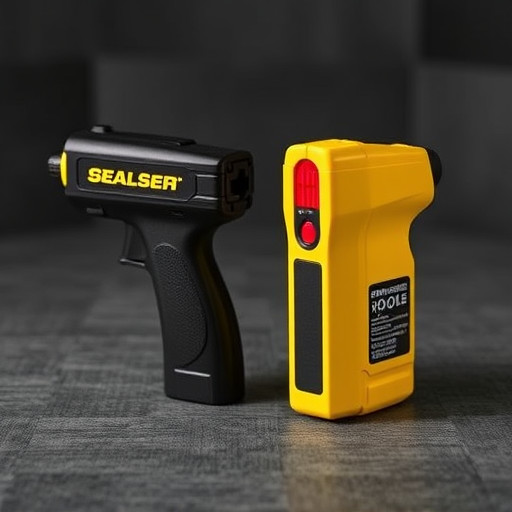This text compares stun guns and tasers, two types of electronic control devices (ECDs) for non-lethal force. Key differences include firing mechanism: stun guns use a single probe for direct contact delivery of high voltage, while tasers fire two fine probes connected by thin wires to cause muscle contractions from a distance. Stun guns offer easier use and portability, ideal for civilian self-defense, whereas tasers are primarily law enforcement tools due to their controlled force application without direct contact. Both have distinct power levels, ranges, and safety features; legality varies by location. Always check local laws and consult reputable sellers for safe and informed choices.
“Unraveling the distinctions between stun guns and tasers is crucial for consumers seeking personal safety tools. This comprehensive guide delves into the unique features of each device, from their key functionalities to power outputs and range capabilities. We’ll explore how stun guns and tasers operate differently, analyzing safety considerations and legal implications. Additionally, we’ll provide insights into what customers can expect during the purchasing process, ensuring informed decisions regarding self-defense options.”
Understanding Stun Guns: Key Features and Functionality
Stun guns, also known as electronic control devices (ECDs), are non-lethal weapons designed to incapacitate a target through electrical discharge. They work by delivering a strong electric current through two metal probes, causing severe muscle contractions and disorientation in the target. This temporary paralysis allows the user to escape or subdue an assailant. Stun guns are typically easy to use, requiring only a simple trigger pull, and they offer a visible deterrent against potential threats.
Key features of stun guns include high voltage output (ranging from 50,000 to 120,000 volts), lightweight and compact design for easy portability, and various safety mechanisms such as motion sensors or safety switches. Unlike tasers, which fire two probes simultaneously, stun guns emit a single probe, making them more suitable for close-range encounters. The difference between stun guns and tasers lies in their firing mechanism, with tasers offering more control over the number of probes discharged and the overall impact area.
Exploring Tasers: Unique Characteristics and Operation
Tasers, a type of electronic control device (ECD), have distinct characteristics and operation compared to stun guns. These devices are designed for law enforcement and security personnel as non-lethal force options during encounters with suspects. A Taser uses two fine probes connected by thin wires that fire into the target’s body. It then delivers an electric current, causing muscles to contract uncontrollably, leading to temporary incapacitation. This unique mechanism allows for a non-deadly response while providing officers with time to subdue or de-escalate a situation.
In contrast, stun guns emit a high-voltage, low-current electrical discharge from a single point source. They typically use either metal probes or a focused beam of electricity to stun a target directly. Stun guns are often considered more accessible to civilians for self-defense due to their ease of use and portability. However, understanding the difference between these two devices is crucial when considering their applications, as Tasers are primarily designed for law enforcement while stun guns cater to personal protection needs.
Comparative Analysis: Power, Range, and Safety Considerations
In comparing stun guns and tasers, understanding their power, range, and safety features is paramount. Stun guns, also known as electroshock weapons, deliver a powerful electric current that temporarily disables a target through muscle confusion. They often have a shorter range, typically up to 20-30 feet, and rely on direct contact with the assailant. Safety-wise, stun guns may require proper training due to their high voltage output.
On the other hand, tasers (or Conductive Energy Devices) use two probes connected by a wire to deliver an electric shock from a safe distance of up to 35 feet. This technology causes muscle contractions, leading to temporary immobilization. Tasers are generally considered safer for users as they don’t require direct contact and offer a more controlled application of force. However, the difference in power and range between stun guns and tasers plays a significant role in choosing the right self-defense tool based on individual needs and potential threat scenarios.
Legal Aspects and Customer Service: What to Expect When Purchasing
When considering the purchase of a self-defense device, understanding the legal aspects is paramount. Both stun guns and tasers are popular choices for personal safety, but their legality varies widely depending on your location. It’s crucial to research and comply with local laws and regulations before making a purchase.
Customer service plays a significant role in this process. Reputable sellers of stun guns and tasers should provide comprehensive information about legal restrictions and offer guidance tailored to your region. They should also be transparent about product features, strengths, and potential risks. Expect clear communication regarding warranty policies, return windows, and after-sales support to ensure you’re satisfied with your purchase and well-informed about responsible use.
